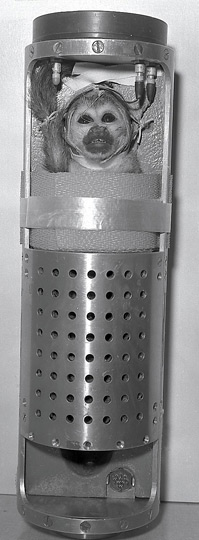50 years of conquering the universe of monkeys
In Huntsville, Alabana state, there is an unusual grave, instead of placing flowers like other tombs, people here often put bananas. On the grave is the words: 'Ms. Baker, the squirrel monkey, the first animal set foot on the universe and survived, May 28, 1959'.
50 years ago, Squirrel Baker and Able, like brown monkeys, made a historic flight into space by Jupiter ballistic missiles. Both were brought to an altitude of 580 km and experienced 9 minutes in weightless condition and returned to the ground safely.
Two years later, people officially set foot on the universe (in 1961, Yuri Gagarin represented humanity to see the earth from outer space). The names of these two monkeys became famous in the world, they appeared in Life magazine, participating in press conferences.
The first living creature returned
Chris Dubbs, co-author of the book Animals in Space: From Research Rockets to Space Shuttle, says Able and Baker are not living creatures. First return to Earth from space, there are many mysteries outside.

Baker is placed in a small storage compartment.
In 1947, the United States "sent" fruit flies to the "reconnaissance" of the universe and these were considered to be the first creatures to fly out of space. For the first time, the United States intended to bring monkeys to space in 1948. However, over a decade, all tests with monkeys failed for one reason or another.
In one case, due to the rocket being exploded, another case was due to the death of the 'monkey astronaut'. In fact, once the animal returned home safely, but the means of bringing them up did not reach enough height to reach outer space.
Meanwhile, the former Soviet Union experimented with dogs and succeeded. The first animal to actually move around Earth's orbit was the Laika dog on Sputnik 2 in 1957, although Laika was unable to survive until the end of the journey. 'Americans are aware of this and the space race is evident after Able and Baker' set foot in space ', Dubbs said.
Two small "astronauts"
Able is a small brown monkey, while Baker has a more modest appearance. The rocket carrying these two tiny "astronauts" took off from Cape Canaveral, Florida and traveled about 2,800 km in 16 minutes, reaching 580 km above sea level.

Able was picked up by sailors after landing in the sea
Joseph Guion, commander of the USS Kiowa, the ship had brought two monkeys to the mainland after landing, said: 'I and the crew thought they were sinking but then a part of the rocket head jutted out of the face. water and they have escaped out, perfect, without difficulty or injury '.
Guion said, he was surprised to see how small the Baker compartment was. 'It's just a small water bottle. Baker is a very easy monkey, like a doll. While Able is the opposite, it's hard to get close to it, ' Guion said.
100 letters a day
Able died a few days later during a medical examination. Able's body is still on display at the Smithsonian National Museum of Space and Air. Baker lived 25 years later at the US Center for Missiles and Space, Huntsville, Alabama.
'Baker receives 100 to 150 letters a day from the children. "She" is a famous figure in the history of American space exploration. The children read about Baker in the textbook and wanted to get to know her , 'said Ed Buckbee, a former director of the center.
The pioneering monkeys on the universe were not forgotten, there were more than 300 people attended Baker's funeral when "she" died of kidney damage in 1984. 'On Baker's grave at the entrance of the center, you will often see people putting bananas here to remember "her", instead of placing flowers like other tombs, " Buckbee said.
- Strange things about monkeys
- 10 astronomical photos accompany the years
- 6 important events that mark 60 years of human conquest of the universe
- Video: The way to flirt with a strange capuchin monkey
- There should put religion on the stars?
- Monkey can identify himself in the mirror
- Video: Six decades of conquering humanity's universe
- Monkeys have the most funny faces
- Iran continues to pursue a plan to bring monkeys to space
- The mysterious monkey eating bamboo in Africa
- Monkeys know to say 'like' people
- America: Will conquer Mars within the next 20 years
 The most famous scientific failures in history
The most famous scientific failures in history Mysterious genius mechanic and the machine froze time
Mysterious genius mechanic and the machine froze time The son carries the 'bad gene' of genius Albert Einstein
The son carries the 'bad gene' of genius Albert Einstein Isaac Newton
Isaac Newton